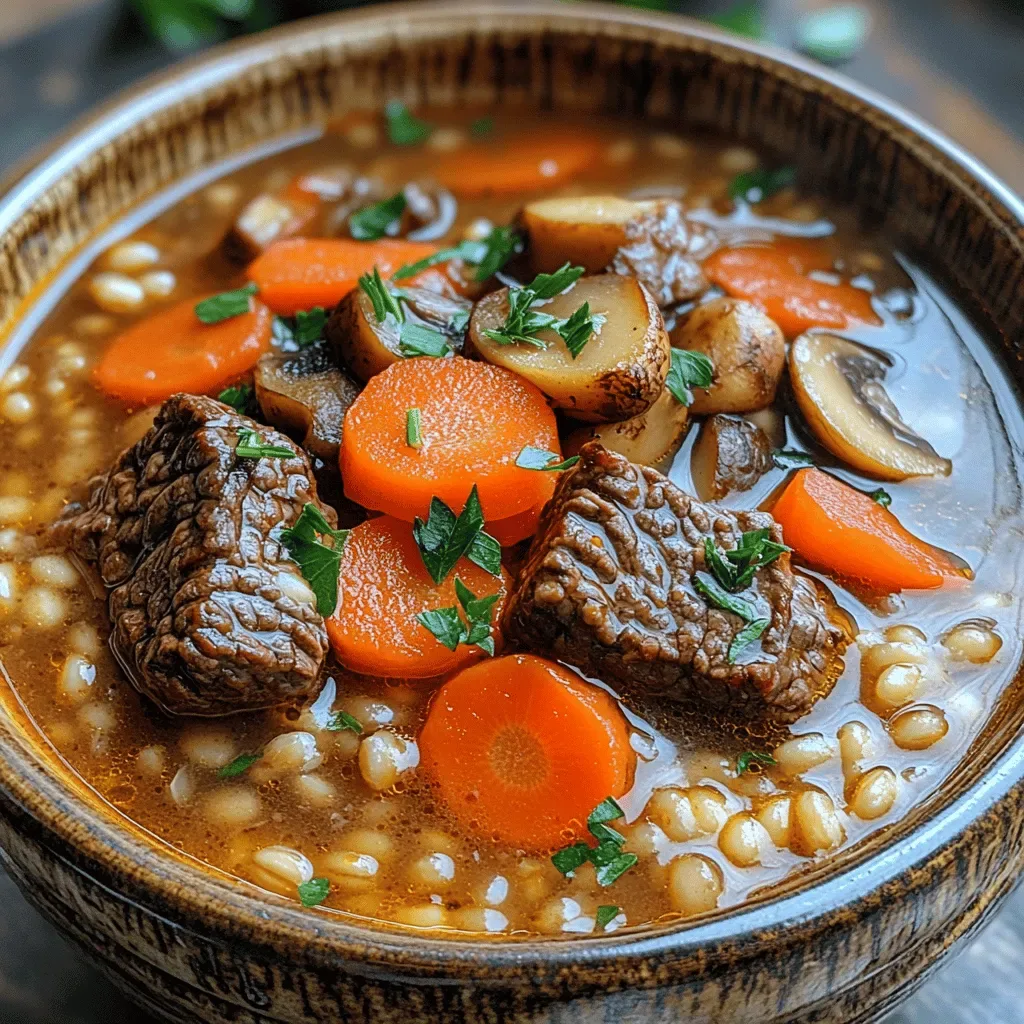There’s something irresistibly comforting about a bowl of soup that warms both body and soul. Our Comforting Hearty Beef and Barley Soup captures that feeling with every spoonful, delivering a rich, satisfying experience that feels like a hug from the inside.
What makes this soup stand out is the marriage of tender, slow‑braised beef with nutty barley, all swimming in a savory broth brightened by fresh vegetables and aromatic herbs. The result is a balanced, full‑flavored bowl that never feels heavy.
This dish is perfect for chilly evenings, family gatherings, or anytime you need a nourishing meal that feeds a crowd. Kids love the soft veggies, while adults appreciate the depth of flavor from the beef and barley.
Preparing the soup is straightforward: sear the beef, sauté the aromatics, then let everything simmer together until the barley is tender and the flavors have melded into a harmonious whole.
Why You'll Love This Recipe
One‑Pot Wonder: Everything cooks together in a single pot, minimizing cleanup while allowing the ingredients to share their flavors for a cohesive, comforting bowl.
Nutritious & Filling: Lean beef provides protein, barley adds fiber, and the vegetables contribute vitamins and minerals, making this a balanced meal that satisfies hunger.
Versatile Temperature: It shines hot on a cold night, yet cools beautifully for a hearty lunch the next day, giving you flexibility in serving.
Budget‑Friendly: Using affordable cuts of beef and pantry staples like barley keeps the cost low without compromising flavor or quality.
Ingredients
For this soup I rely on a handful of core ingredients that each play a distinct role. The beef provides a rich, meaty backbone, while barley contributes a pleasant chew and thickens the broth naturally. Fresh vegetables add sweetness and texture, and a blend of herbs and spices builds depth without overwhelming the palate.
Main Ingredients
- 1.5 lb (≈ 680 g) beef stew meat, cut into 1‑inch cubes
- 1 cup pearl barley, rinsed
- 2 large carrots, diced
- 2 celery stalks, sliced
- 1 large onion, finely chopped
- 3 garlic cloves, minced
- 2 medium potatoes, cubed
- 6 cups beef broth (low‑sodium)
- 2 tbsp tomato paste
- 2 tbsp olive oil
Seasonings & Herbs
- 1 tsp salt (adjust to taste)
- ½ tsp freshly ground black pepper
- 1 bay leaf
- 1 tsp dried thyme
- ½ tsp smoked paprika
Garnish
- 2 tbsp fresh parsley, chopped
The combination of these ingredients creates a soup that is both hearty and nuanced. The beef releases gelatin that enriches the broth, while barley absorbs liquid and releases starch, giving the soup a naturally thick texture. Aromatics like onion, garlic, and thyme provide a fragrant backbone, and the final sprinkle of parsley adds a fresh, bright finish.
Step-by-Step Instructions

Preparing the Soup Base
Begin by patting the beef cubes dry with paper towels; this step is essential for a good sear. Toss the meat with a pinch of salt and pepper, then set aside while you prep the vegetables. Dice carrots, celery, onion, and potatoes so they are uniform—this ensures even cooking and consistent texture throughout the soup.
Building Flavor
- Brown the Beef. Heat 2 tbsp olive oil in a large Dutch oven over medium‑high heat. Add the seasoned beef in a single layer, leaving space between pieces. Let it develop a deep brown crust, about 4‑5 minutes per side, then remove with a slotted spoon and set aside. This Maillard reaction adds depth to the final broth.
- Sauté Aromatics. In the same pot, reduce heat to medium and add the chopped onion, carrots, and celery. Cook, stirring occasionally, for 5‑6 minutes until the vegetables soften and the onion turns translucent. Add the minced garlic and smoked paprika, stirring for another 30 seconds until fragrant.
- Deglaze & Add Tomato Paste. Stir in 2 tbsp tomato paste, letting it caramelize for 2 minutes. Pour in a splash of beef broth and scrape the browned bits from the bottom of the pot—these fond pieces are flavor gold.
- Combine Main Components. Return the browned beef to the pot, then add the cubed potatoes, rinsed barley, remaining beef broth, bay leaf, thyme, and a final pinch of salt and pepper. Bring the mixture to a gentle boil, then reduce to a low simmer.
- Simmer Until Tender. Cover partially and let the soup simmer for 45‑55 minutes, stirring occasionally. The barley should be tender but still retain a slight bite, and the beef must be fork‑tender. If the soup becomes too thick, add a little water or extra broth.
Finishing Touches & Serving
Once the barley and beef have reached the perfect texture, discard the bay leaf. Taste and adjust seasoning with more salt or pepper if needed. Ladle the soup into bowls and sprinkle each serving with 2 tbsp fresh parsley for color and a pop of freshness. Serve hot with crusty bread or a simple side salad for a complete meal.
Tips & Tricks
Perfecting the Recipe
Pat the Beef Dry. Moisture on the surface prevents proper browning, resulting in a less flavorful broth.
Use a Heavy‑Bottomed Pot. Even heat distribution avoids scorching and promotes gentle simmering.
Rinse Barley Before Adding. This removes excess starch that can make the soup gummy.
Flavor Enhancements
Finish the soup with a splash of Worcestershire sauce for umami depth, or stir in a teaspoon of sherry for subtle sweetness. A pinch of fresh thyme leaves added at the end brightens the overall profile.
Common Mistakes to Avoid
Avoid boiling the soup vigorously; a hard boil can break down barley too quickly, leading to a mushy texture. Also, don’t add the parsley too early—its flavor fades with prolonged heat, so sprinkle it just before serving.
Pro Tips
Make a Soup Stock. Use the beef bones from a previous roast to boost broth richness.
Adjust Thickness. If you prefer a thicker stew, mash a few barley grains against the side of the pot and stir them in.
Season in Layers. Add a little salt after browning the beef, then again after the broth is added, to build depth.
Variations
Ingredient Swaps
Replace beef with lamb for a richer, gamey flavor, or use boneless pork shoulder for a slightly sweeter profile. Swap pearl barley for farro or quinoa to change the texture while keeping the soup hearty. For a vegetarian version, substitute the beef with mushrooms and use vegetable broth.
Dietary Adjustments
To make the soup gluten‑free, choose certified gluten‑free barley or replace it with millet. For low‑sodium needs, opt for a reduced‑salt broth and limit added salt. If you’re avoiding dairy, the recipe is already dairy‑free; just ensure any garnish (like butter) is omitted.
Serving Suggestions
Pair the soup with a slice of crusty sourdough or a warm garlic naan to soak up the broth. A simple arugula salad dressed with lemon vinaigrette adds a peppery contrast. For a festive touch, serve alongside roasted root vegetables.
Storage Info
Leftover Storage
Allow the soup to cool to room temperature, then transfer it to airtight containers. It keeps well in the refrigerator for 3‑4 days. For longer storage, portion into freezer‑safe bags or containers and freeze for up to 3 months; label with the date for easy reference.
Reheating Instructions
Reheat gently on the stovetop over medium‑low heat, stirring occasionally, until the soup reaches a rolling simmer. Add a splash of broth or water if it has thickened. In a microwave, heat individual portions covered for 2‑3 minutes, stirring halfway through, and finish with a quick stir before serving.
Frequently Asked Questions
This Comforting Hearty Beef and Barley Soup brings together simple pantry staples and a few fresh touches to create a meal that feels both rustic and refined. With clear steps, helpful tips, and adaptable variations, you can make it your own every time you cook. Serve it hot, share it with loved ones, and enjoy the cozy, satisfying flavors that only a well‑crafted soup can deliver.










